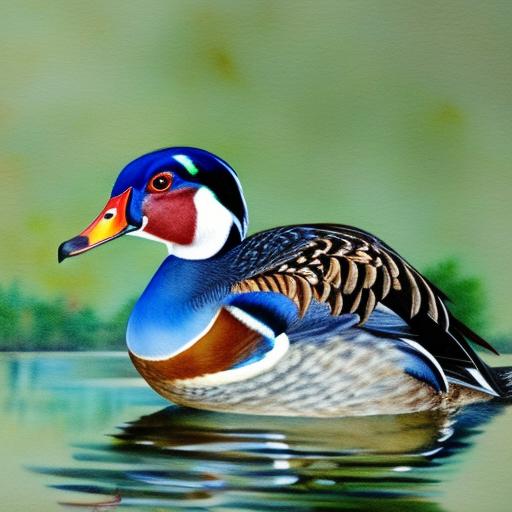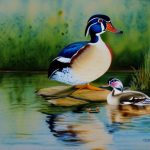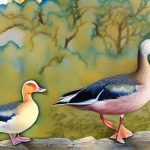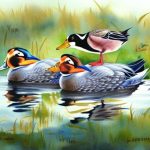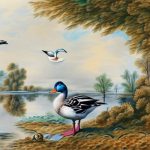The male wood duck, scientifically known as Aix sponsa, is a stunningly beautiful bird that is native to North America. One of the most fascinating aspects of the male wood duck is its striking and vibrant breeding plumage, which has captivated birdwatchers and nature enthusiasts for centuries. However, what is often overlooked is the equally remarkable non-breeding plumage of the male wood duck. During the non-breeding season, these birds undergo a dramatic transformation in their appearance, shedding their colorful breeding plumage for a more subdued and cryptic look. This non-breeding plumage serves several important purposes for the male wood duck, and understanding its significance is crucial for appreciating the full complexity of this species.
Key Takeaways
- Male wood ducks have a distinct non-breeding plumage that differs from their breeding plumage.
- Non-breeding plumage is characterized by duller colors and less distinct markings compared to breeding plumage.
- The differences between breeding and non-breeding plumage serve as a form of camouflage and protection for male wood ducks.
- Non-breeding plumage helps male wood ducks conserve energy and resources during the non-breeding season.
- Male wood ducks exhibit changes in behavior during the non-breeding season, such as forming flocks and engaging in less territorial behavior.
Description of Male Wood Duck Non-Breeding Plumage
The non-breeding plumage of the male wood duck is a sight to behold, albeit in a more understated manner compared to its breeding plumage. During this time, the male wood duck’s head and crest lose their iridescent green and purple hues, instead taking on a more muted brown and gray coloration. The distinctive white throat patch that is so prominent during the breeding season becomes less conspicuous, blending in with the overall earthy tones of the bird’s plumage. The body of the male wood duck also undergoes a transformation, with the bright chestnut and bronze colors giving way to a more subdued brown and gray appearance. The overall effect is a bird that is much less eye-catching than its breeding counterpart, but no less beautiful in its own right.
During the non-breeding season, the male wood duck’s appearance becomes more camouflaged and cryptic, allowing it to blend in seamlessly with its surroundings. This change in plumage serves as a form of protection for the bird, helping it to evade predators and remain undetected while it goes about its daily activities. Additionally, the non-breeding plumage allows the male wood duck to conserve energy by reducing the need to maintain the vibrant colors of its breeding plumage. This is especially important during the winter months when resources may be scarce, and the bird needs to allocate its energy efficiently in order to survive. Overall, the non-breeding plumage of the male wood duck is a marvel of natural adaptation, allowing the bird to thrive in its environment during a crucial time of year.
Differences Between Breeding and Non-Breeding Plumage
The differences between the breeding and non-breeding plumage of the male wood duck are stark and readily apparent to even casual observers. During the breeding season, the male wood duck sports a dazzling array of colors, including iridescent greens, purples, chestnuts, and whites. These vibrant hues are designed to attract females and establish dominance among other males during courtship displays. In contrast, the non-breeding plumage of the male wood duck is much more subdued, with earthy browns, grays, and muted whites dominating its appearance. This change in coloration serves a dual purpose: it allows the male wood duck to blend in with its surroundings for protection, while also conserving energy during a time when resources may be scarce.
Another key difference between breeding and non-breeding plumage is the overall appearance of the male wood duck’s head and crest. During the breeding season, the male wood duck’s head is adorned with a striking iridescent green and purple crest, which serves as a visual cue for potential mates. In contrast, the non-breeding plumage sees this crest lose its vibrant colors, instead taking on a more subdued brown and gray appearance. This change in coloration not only helps the male wood duck to remain inconspicuous in its environment but also signals a shift in behavior and reproductive status. Overall, the differences between breeding and non-breeding plumage in the male wood duck are a testament to the bird’s adaptability and resilience in the face of changing environmental conditions.
Reasons for Non-Breeding Plumage
The non-breeding plumage of the male wood duck serves several important purposes that are crucial for its survival and reproductive success. One of the primary reasons for this change in appearance is camouflage. During the non-breeding season, when resources may be scarce and predators are abundant, it is essential for the male wood duck to blend in with its surroundings in order to avoid detection. The earthy browns, grays, and muted whites of its non-breeding plumage allow the bird to remain inconspicuous while foraging for food or seeking shelter, increasing its chances of survival during this challenging time of year.
Another reason for the non-breeding plumage is energy conservation. Maintaining the vibrant colors of its breeding plumage requires a significant amount of energy expenditure for the male wood duck. During the non-breeding season, when resources may be limited, it is crucial for the bird to conserve energy in order to survive. By shedding its bright colors in favor of more subdued tones, the male wood duck can allocate its energy more efficiently, increasing its chances of making it through the winter months. This adaptation is a testament to the bird’s ability to thrive in a variety of environmental conditions and underscores the importance of non-breeding plumage in its life cycle.
Behavioral Changes in Male Wood Ducks During Non-Breeding Season
The non-breeding season brings about significant behavioral changes in male wood ducks as they transition from their vibrant breeding plumage to their more subdued non-breeding plumage. One notable change is a decrease in territorial behavior and aggression towards other males. During the breeding season, male wood ducks fiercely defend their territories and compete with other males for access to females. However, as they enter the non-breeding season, these aggressive behaviors diminish as their focus shifts from courtship and mating to survival and conservation of energy.
Another behavioral change during the non-breeding season is an increase in socialization among male wood ducks. While they may still maintain some level of territoriality, they are more likely to tolerate each other’s presence and even form loose associations while foraging or resting. This shift towards more cooperative behavior allows male wood ducks to benefit from safety in numbers and share information about food sources or potential threats in their environment. Overall, these behavioral changes during the non-breeding season reflect the male wood duck’s ability to adapt to changing environmental conditions and prioritize survival over reproductive activities.
Importance of Non-Breeding Plumage in Male Wood Duck’s Life Cycle
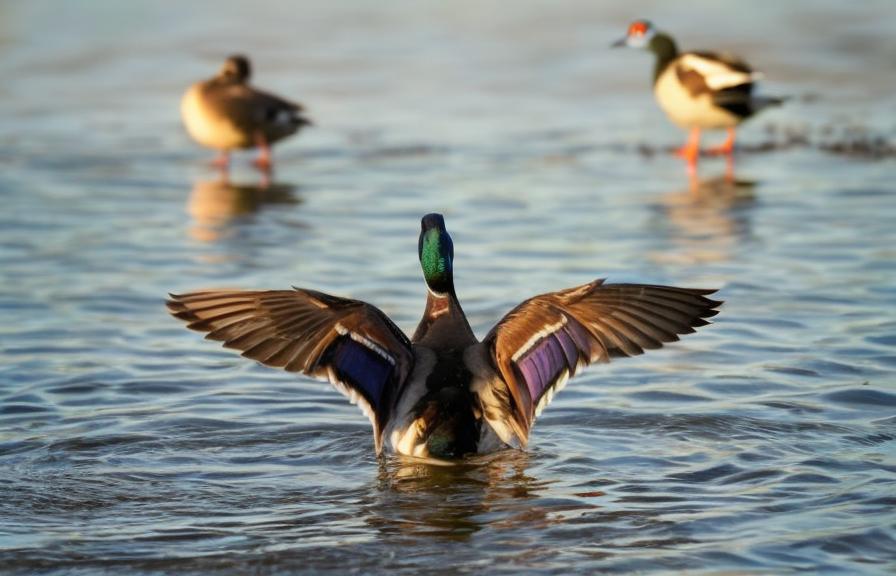
The non-breeding plumage of the male wood duck plays a crucial role in its life cycle by allowing it to adapt to changing environmental conditions and maximize its chances of survival during challenging times of year. By shedding its vibrant breeding colors in favor of more subdued tones, the male wood duck can blend in with its surroundings and avoid detection by predators. This camouflage is essential for allowing the bird to forage for food, seek shelter, and rest without drawing unwanted attention that could jeopardize its safety.
Additionally, the non-breeding plumage allows male wood ducks to conserve energy during a time when resources may be scarce. By reducing the energy expenditure required to maintain their bright colors, these birds can allocate their resources more efficiently towards essential activities such as foraging, thermoregulation, and avoiding predators. This energy conservation is crucial for their survival during the winter months when food sources may be limited and harsh weather conditions pose additional challenges.
Overall, the importance of non-breeding plumage in the male wood duck’s life cycle cannot be overstated. It represents a remarkable adaptation that allows these birds to thrive in a variety of environmental conditions and underscores their resilience in the face of changing seasons.
Conservation and Protection of Male Wood Duck Non-Breeding Plumage
Conservation and protection efforts for male wood ducks should take into account the significance of their non-breeding plumage in their life cycle. Preserving habitats that provide ample cover and resources during the non-breeding season is crucial for ensuring that these birds can successfully transition between their breeding and non-breeding plumages without undue stress or hardship.
Additionally, efforts to mitigate human disturbances in areas where male wood ducks congregate during the non-breeding season can help minimize disruptions to their natural behaviors and activities. This includes limiting human access to sensitive habitats, reducing noise pollution, and minimizing disturbances that could cause unnecessary stress or displacement for these birds.
Furthermore, raising awareness about the importance of non-breeding plumage in male wood ducks can help garner support for conservation initiatives aimed at protecting their habitats and ensuring their long-term survival. By highlighting the role that non-breeding plumage plays in their ability to thrive in changing environmental conditions, conservationists can rally public support for measures that safeguard these birds and their critical habitats.
In conclusion, understanding and appreciating the significance of non-breeding plumage in male wood ducks is essential for ensuring their continued survival and well-being. By recognizing the importance of this remarkable adaptation, we can work towards conserving and protecting these birds for future generations to enjoy and appreciate.
When it comes to the non-breeding plumage of male wood ducks, it’s fascinating to observe the vibrant and intricate patterns that adorn their feathers. This striking display is a testament to the beauty of nature and the wonders of avian biology. If you’re interested in learning more about caring for waterfowl and enhancing their natural habitats, check out this insightful article on how to care for goslings. Understanding the needs of waterfowl can provide valuable insights into creating a nurturing environment for these magnificent creatures.
FAQs
What is the non-breeding plumage of a male wood duck?
The non-breeding plumage of a male wood duck is characterized by a more subdued and dull coloration compared to their vibrant breeding plumage. They have a grayish body with a white belly, a distinctive white eye-ring, and a red bill.
Why do male wood ducks have different plumage during non-breeding season?
Male wood ducks have different plumage during the non-breeding season as a form of camouflage to help them blend in with their surroundings and avoid predators. This duller plumage helps them to remain inconspicuous while they are not actively courting females.
When do male wood ducks transition to their non-breeding plumage?
Male wood ducks typically transition to their non-breeding plumage in late summer or early fall, after the breeding season has ended. This change in plumage helps them to adapt to the changing environmental conditions and behavioral patterns.
Do male wood ducks revert back to their breeding plumage?
Yes, male wood ducks will revert back to their vibrant breeding plumage as the breeding season approaches. This transformation usually occurs in late winter or early spring, in preparation for courtship and mating.
How can you distinguish a male wood duck in non-breeding plumage from a female?
Even in non-breeding plumage, male wood ducks can still be distinguished from females by their overall shape and size, as well as the distinctive white eye-ring and red bill. Females have a more mottled brown appearance and lack the striking markings of the males.
Meet Walter, the feathered-friend fanatic of Florida! Nestled in the sunshine state, Walter struts through life with his feathered companions, clucking his way to happiness. With a coop that’s fancier than a five-star hotel, he’s the Don Juan of the chicken world. When he’s not teaching his hens to do the cha-cha, you’ll find him in a heated debate with his prized rooster, Sir Clucks-a-Lot. Walter’s poultry passion is no yolk; he’s the sunny-side-up guy you never knew you needed in your flock of friends!

